User-Centered Interface Design: A Case Study on Smudge-It Travel App
VerifiedAdded on 2023/04/19
|11
|2960
|412
Report
AI Summary
This report presents a case study on Barbara, an employee at Smudge-It Travel, who aims to develop a user-centered application to facilitate group travel planning. The report focuses on applying Don Norman's principles of user interface design to the application, emphasizing the importance of user satisfaction and ease of use. The discussion covers Norman's six key principles: visibility, feedback, affordance, mapping, constraints, and consistency, and illustrates how each principle can be implemented in the design of the travel application. The report highlights how the application should enable users to find travel partners, input preferences, and receive personalized suggestions, while ensuring a seamless and intuitive user experience. The objective is to design an interface that is not only visually appealing but also highly functional and responsive to user needs, ultimately aiming to maximize user engagement and satisfaction.
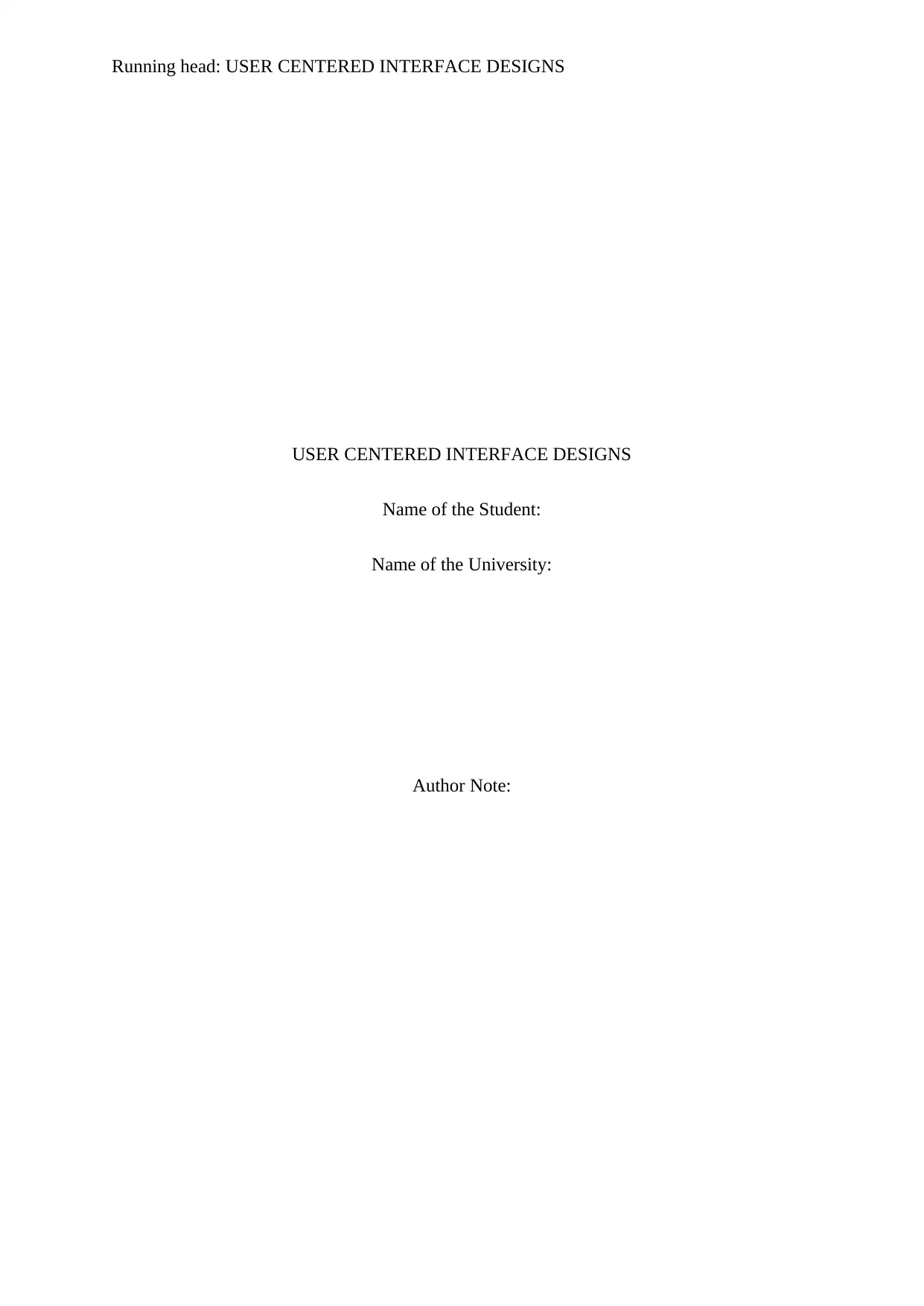
Running head: USER CENTERED INTERFACE DESIGNS
USER CENTERED INTERFACE DESIGNS
Name of the Student:
Name of the University:
Author Note:
USER CENTERED INTERFACE DESIGNS
Name of the Student:
Name of the University:
Author Note:
Paraphrase This Document
Need a fresh take? Get an instant paraphrase of this document with our AI Paraphraser
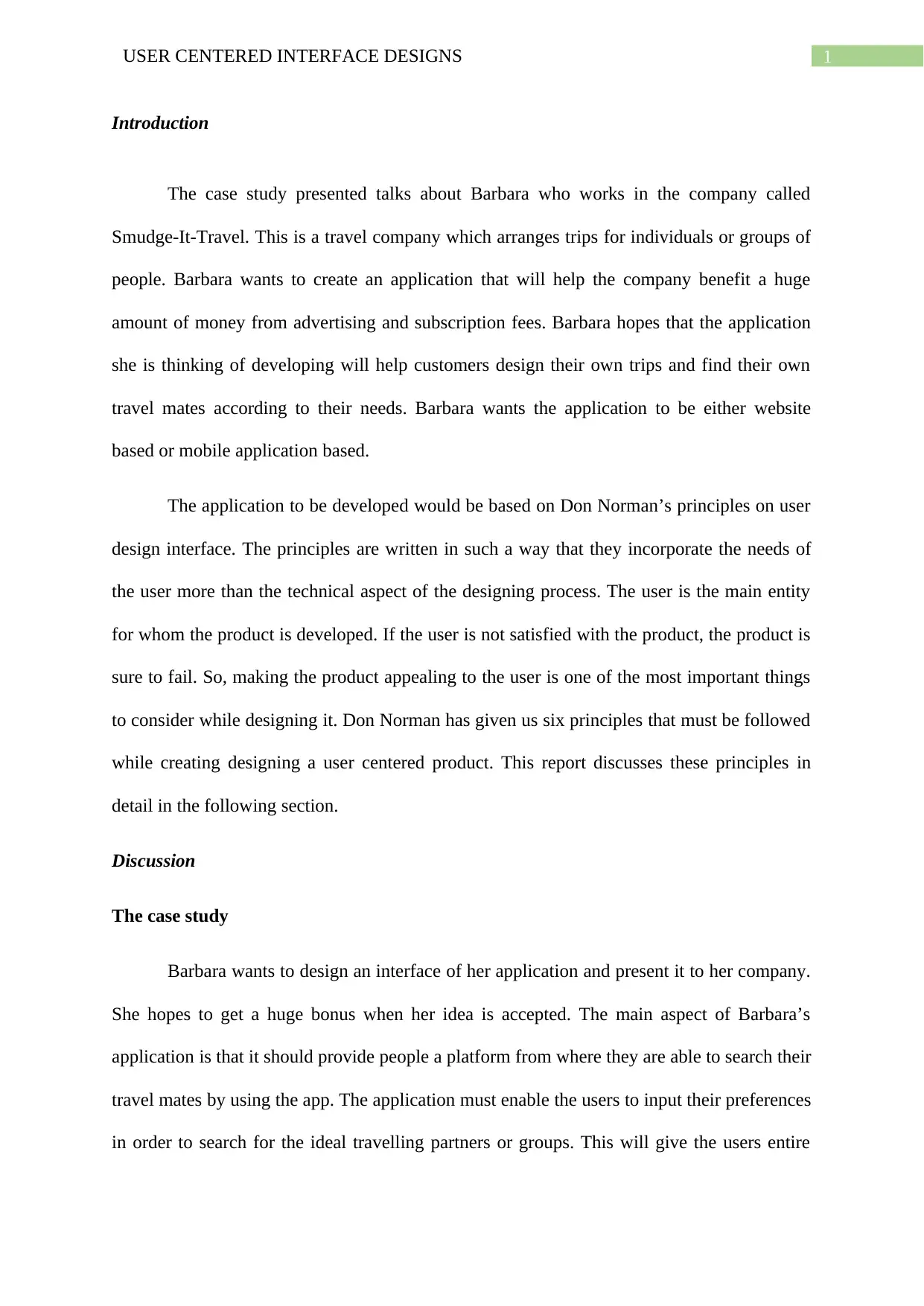
1USER CENTERED INTERFACE DESIGNS
Introduction
The case study presented talks about Barbara who works in the company called
Smudge-It-Travel. This is a travel company which arranges trips for individuals or groups of
people. Barbara wants to create an application that will help the company benefit a huge
amount of money from advertising and subscription fees. Barbara hopes that the application
she is thinking of developing will help customers design their own trips and find their own
travel mates according to their needs. Barbara wants the application to be either website
based or mobile application based.
The application to be developed would be based on Don Norman’s principles on user
design interface. The principles are written in such a way that they incorporate the needs of
the user more than the technical aspect of the designing process. The user is the main entity
for whom the product is developed. If the user is not satisfied with the product, the product is
sure to fail. So, making the product appealing to the user is one of the most important things
to consider while designing it. Don Norman has given us six principles that must be followed
while creating designing a user centered product. This report discusses these principles in
detail in the following section.
Discussion
The case study
Barbara wants to design an interface of her application and present it to her company.
She hopes to get a huge bonus when her idea is accepted. The main aspect of Barbara’s
application is that it should provide people a platform from where they are able to search their
travel mates by using the app. The application must enable the users to input their preferences
in order to search for the ideal travelling partners or groups. This will give the users entire
Introduction
The case study presented talks about Barbara who works in the company called
Smudge-It-Travel. This is a travel company which arranges trips for individuals or groups of
people. Barbara wants to create an application that will help the company benefit a huge
amount of money from advertising and subscription fees. Barbara hopes that the application
she is thinking of developing will help customers design their own trips and find their own
travel mates according to their needs. Barbara wants the application to be either website
based or mobile application based.
The application to be developed would be based on Don Norman’s principles on user
design interface. The principles are written in such a way that they incorporate the needs of
the user more than the technical aspect of the designing process. The user is the main entity
for whom the product is developed. If the user is not satisfied with the product, the product is
sure to fail. So, making the product appealing to the user is one of the most important things
to consider while designing it. Don Norman has given us six principles that must be followed
while creating designing a user centered product. This report discusses these principles in
detail in the following section.
Discussion
The case study
Barbara wants to design an interface of her application and present it to her company.
She hopes to get a huge bonus when her idea is accepted. The main aspect of Barbara’s
application is that it should provide people a platform from where they are able to search their
travel mates by using the app. The application must enable the users to input their preferences
in order to search for the ideal travelling partners or groups. This will give the users entire
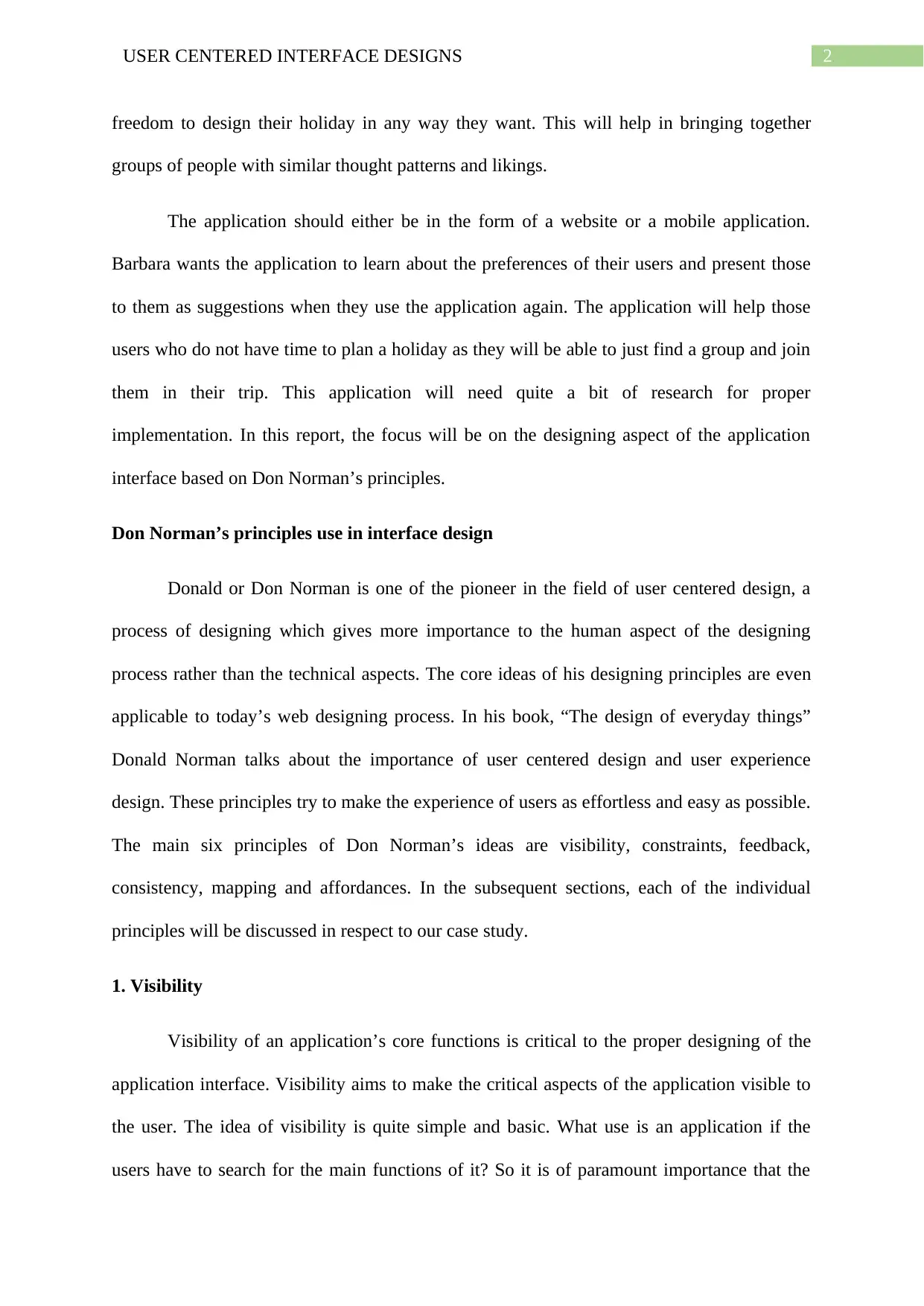
2USER CENTERED INTERFACE DESIGNS
freedom to design their holiday in any way they want. This will help in bringing together
groups of people with similar thought patterns and likings.
The application should either be in the form of a website or a mobile application.
Barbara wants the application to learn about the preferences of their users and present those
to them as suggestions when they use the application again. The application will help those
users who do not have time to plan a holiday as they will be able to just find a group and join
them in their trip. This application will need quite a bit of research for proper
implementation. In this report, the focus will be on the designing aspect of the application
interface based on Don Norman’s principles.
Don Norman’s principles use in interface design
Donald or Don Norman is one of the pioneer in the field of user centered design, a
process of designing which gives more importance to the human aspect of the designing
process rather than the technical aspects. The core ideas of his designing principles are even
applicable to today’s web designing process. In his book, “The design of everyday things”
Donald Norman talks about the importance of user centered design and user experience
design. These principles try to make the experience of users as effortless and easy as possible.
The main six principles of Don Norman’s ideas are visibility, constraints, feedback,
consistency, mapping and affordances. In the subsequent sections, each of the individual
principles will be discussed in respect to our case study.
1. Visibility
Visibility of an application’s core functions is critical to the proper designing of the
application interface. Visibility aims to make the critical aspects of the application visible to
the user. The idea of visibility is quite simple and basic. What use is an application if the
users have to search for the main functions of it? So it is of paramount importance that the
freedom to design their holiday in any way they want. This will help in bringing together
groups of people with similar thought patterns and likings.
The application should either be in the form of a website or a mobile application.
Barbara wants the application to learn about the preferences of their users and present those
to them as suggestions when they use the application again. The application will help those
users who do not have time to plan a holiday as they will be able to just find a group and join
them in their trip. This application will need quite a bit of research for proper
implementation. In this report, the focus will be on the designing aspect of the application
interface based on Don Norman’s principles.
Don Norman’s principles use in interface design
Donald or Don Norman is one of the pioneer in the field of user centered design, a
process of designing which gives more importance to the human aspect of the designing
process rather than the technical aspects. The core ideas of his designing principles are even
applicable to today’s web designing process. In his book, “The design of everyday things”
Donald Norman talks about the importance of user centered design and user experience
design. These principles try to make the experience of users as effortless and easy as possible.
The main six principles of Don Norman’s ideas are visibility, constraints, feedback,
consistency, mapping and affordances. In the subsequent sections, each of the individual
principles will be discussed in respect to our case study.
1. Visibility
Visibility of an application’s core functions is critical to the proper designing of the
application interface. Visibility aims to make the critical aspects of the application visible to
the user. The idea of visibility is quite simple and basic. What use is an application if the
users have to search for the main functions of it? So it is of paramount importance that the
⊘ This is a preview!⊘
Do you want full access?
Subscribe today to unlock all pages.

Trusted by 1+ million students worldwide
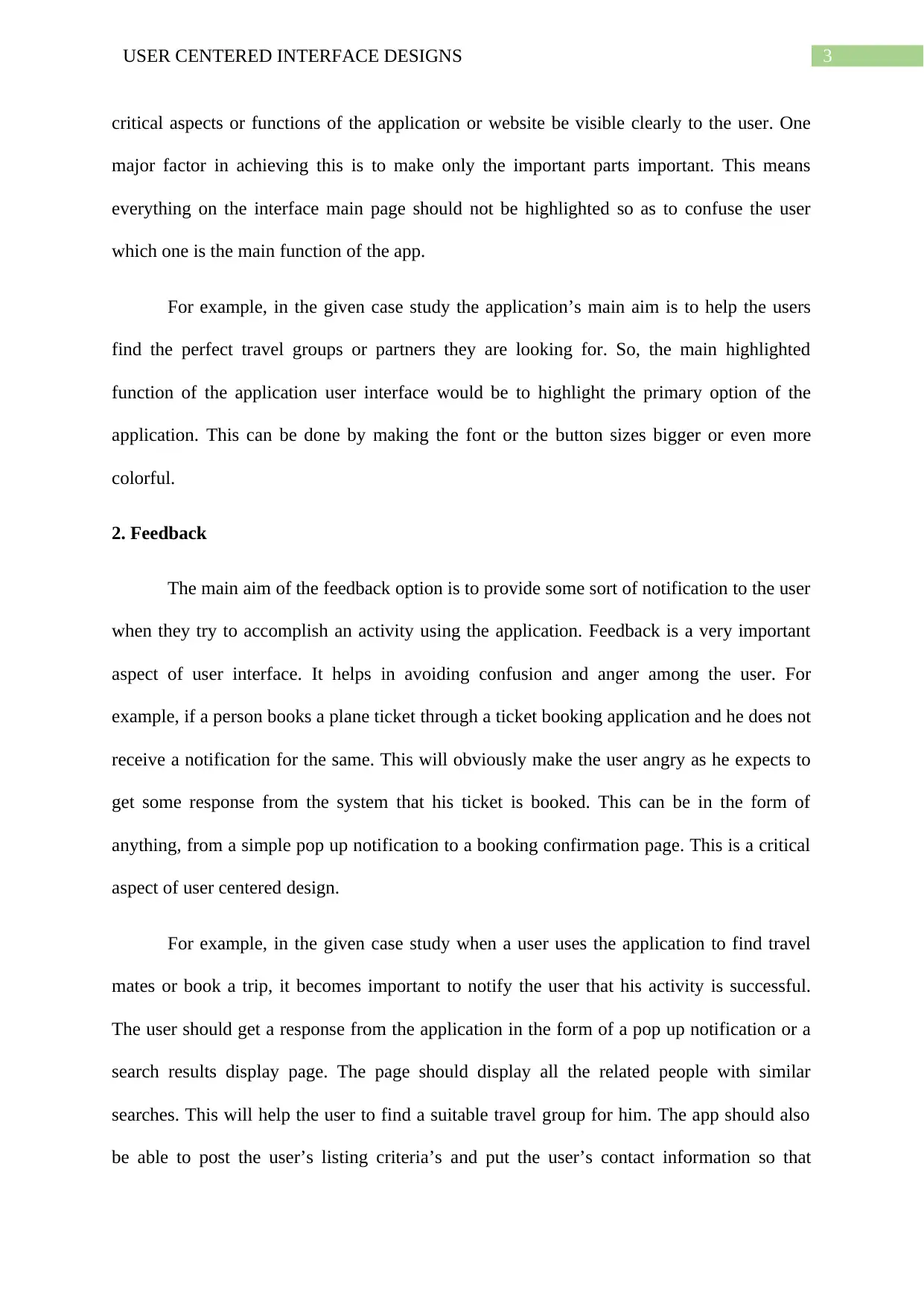
3USER CENTERED INTERFACE DESIGNS
critical aspects or functions of the application or website be visible clearly to the user. One
major factor in achieving this is to make only the important parts important. This means
everything on the interface main page should not be highlighted so as to confuse the user
which one is the main function of the app.
For example, in the given case study the application’s main aim is to help the users
find the perfect travel groups or partners they are looking for. So, the main highlighted
function of the application user interface would be to highlight the primary option of the
application. This can be done by making the font or the button sizes bigger or even more
colorful.
2. Feedback
The main aim of the feedback option is to provide some sort of notification to the user
when they try to accomplish an activity using the application. Feedback is a very important
aspect of user interface. It helps in avoiding confusion and anger among the user. For
example, if a person books a plane ticket through a ticket booking application and he does not
receive a notification for the same. This will obviously make the user angry as he expects to
get some response from the system that his ticket is booked. This can be in the form of
anything, from a simple pop up notification to a booking confirmation page. This is a critical
aspect of user centered design.
For example, in the given case study when a user uses the application to find travel
mates or book a trip, it becomes important to notify the user that his activity is successful.
The user should get a response from the application in the form of a pop up notification or a
search results display page. The page should display all the related people with similar
searches. This will help the user to find a suitable travel group for him. The app should also
be able to post the user’s listing criteria’s and put the user’s contact information so that
critical aspects or functions of the application or website be visible clearly to the user. One
major factor in achieving this is to make only the important parts important. This means
everything on the interface main page should not be highlighted so as to confuse the user
which one is the main function of the app.
For example, in the given case study the application’s main aim is to help the users
find the perfect travel groups or partners they are looking for. So, the main highlighted
function of the application user interface would be to highlight the primary option of the
application. This can be done by making the font or the button sizes bigger or even more
colorful.
2. Feedback
The main aim of the feedback option is to provide some sort of notification to the user
when they try to accomplish an activity using the application. Feedback is a very important
aspect of user interface. It helps in avoiding confusion and anger among the user. For
example, if a person books a plane ticket through a ticket booking application and he does not
receive a notification for the same. This will obviously make the user angry as he expects to
get some response from the system that his ticket is booked. This can be in the form of
anything, from a simple pop up notification to a booking confirmation page. This is a critical
aspect of user centered design.
For example, in the given case study when a user uses the application to find travel
mates or book a trip, it becomes important to notify the user that his activity is successful.
The user should get a response from the application in the form of a pop up notification or a
search results display page. The page should display all the related people with similar
searches. This will help the user to find a suitable travel group for him. The app should also
be able to post the user’s listing criteria’s and put the user’s contact information so that
Paraphrase This Document
Need a fresh take? Get an instant paraphrase of this document with our AI Paraphraser
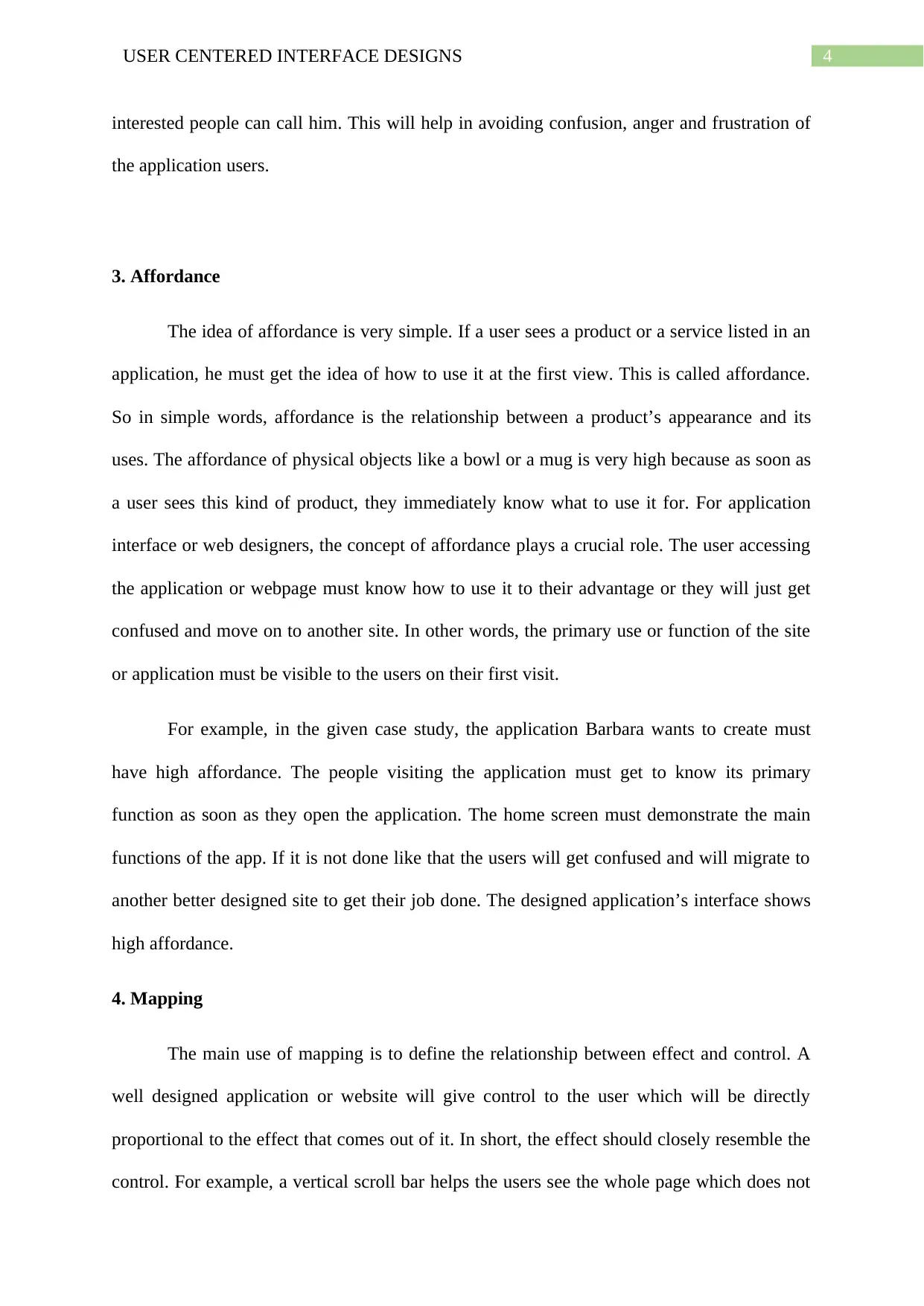
4USER CENTERED INTERFACE DESIGNS
interested people can call him. This will help in avoiding confusion, anger and frustration of
the application users.
3. Affordance
The idea of affordance is very simple. If a user sees a product or a service listed in an
application, he must get the idea of how to use it at the first view. This is called affordance.
So in simple words, affordance is the relationship between a product’s appearance and its
uses. The affordance of physical objects like a bowl or a mug is very high because as soon as
a user sees this kind of product, they immediately know what to use it for. For application
interface or web designers, the concept of affordance plays a crucial role. The user accessing
the application or webpage must know how to use it to their advantage or they will just get
confused and move on to another site. In other words, the primary use or function of the site
or application must be visible to the users on their first visit.
For example, in the given case study, the application Barbara wants to create must
have high affordance. The people visiting the application must get to know its primary
function as soon as they open the application. The home screen must demonstrate the main
functions of the app. If it is not done like that the users will get confused and will migrate to
another better designed site to get their job done. The designed application’s interface shows
high affordance.
4. Mapping
The main use of mapping is to define the relationship between effect and control. A
well designed application or website will give control to the user which will be directly
proportional to the effect that comes out of it. In short, the effect should closely resemble the
control. For example, a vertical scroll bar helps the users see the whole page which does not
interested people can call him. This will help in avoiding confusion, anger and frustration of
the application users.
3. Affordance
The idea of affordance is very simple. If a user sees a product or a service listed in an
application, he must get the idea of how to use it at the first view. This is called affordance.
So in simple words, affordance is the relationship between a product’s appearance and its
uses. The affordance of physical objects like a bowl or a mug is very high because as soon as
a user sees this kind of product, they immediately know what to use it for. For application
interface or web designers, the concept of affordance plays a crucial role. The user accessing
the application or webpage must know how to use it to their advantage or they will just get
confused and move on to another site. In other words, the primary use or function of the site
or application must be visible to the users on their first visit.
For example, in the given case study, the application Barbara wants to create must
have high affordance. The people visiting the application must get to know its primary
function as soon as they open the application. The home screen must demonstrate the main
functions of the app. If it is not done like that the users will get confused and will migrate to
another better designed site to get their job done. The designed application’s interface shows
high affordance.
4. Mapping
The main use of mapping is to define the relationship between effect and control. A
well designed application or website will give control to the user which will be directly
proportional to the effect that comes out of it. In short, the effect should closely resemble the
control. For example, a vertical scroll bar helps the users see the whole page which does not
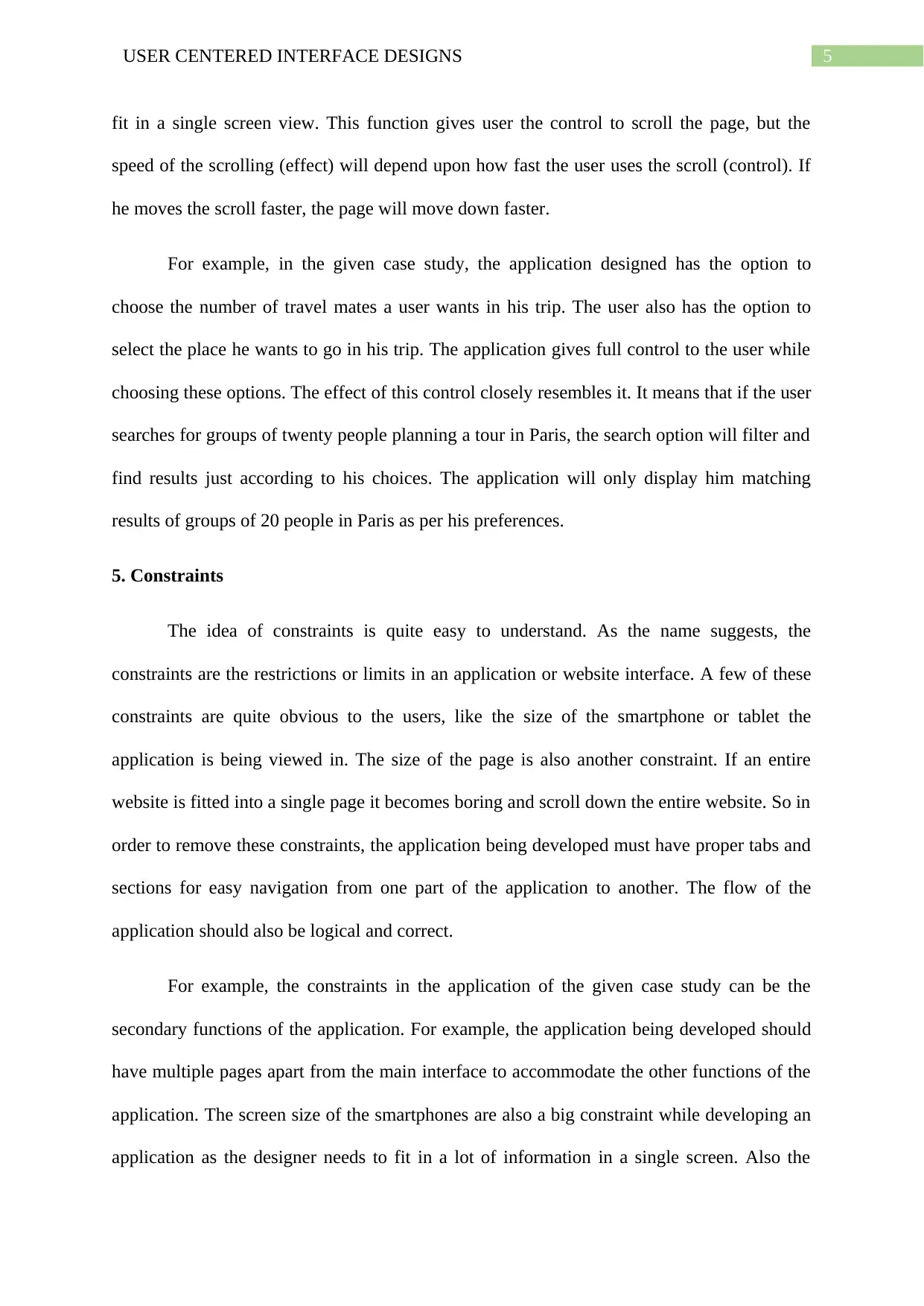
5USER CENTERED INTERFACE DESIGNS
fit in a single screen view. This function gives user the control to scroll the page, but the
speed of the scrolling (effect) will depend upon how fast the user uses the scroll (control). If
he moves the scroll faster, the page will move down faster.
For example, in the given case study, the application designed has the option to
choose the number of travel mates a user wants in his trip. The user also has the option to
select the place he wants to go in his trip. The application gives full control to the user while
choosing these options. The effect of this control closely resembles it. It means that if the user
searches for groups of twenty people planning a tour in Paris, the search option will filter and
find results just according to his choices. The application will only display him matching
results of groups of 20 people in Paris as per his preferences.
5. Constraints
The idea of constraints is quite easy to understand. As the name suggests, the
constraints are the restrictions or limits in an application or website interface. A few of these
constraints are quite obvious to the users, like the size of the smartphone or tablet the
application is being viewed in. The size of the page is also another constraint. If an entire
website is fitted into a single page it becomes boring and scroll down the entire website. So in
order to remove these constraints, the application being developed must have proper tabs and
sections for easy navigation from one part of the application to another. The flow of the
application should also be logical and correct.
For example, the constraints in the application of the given case study can be the
secondary functions of the application. For example, the application being developed should
have multiple pages apart from the main interface to accommodate the other functions of the
application. The screen size of the smartphones are also a big constraint while developing an
application as the designer needs to fit in a lot of information in a single screen. Also the
fit in a single screen view. This function gives user the control to scroll the page, but the
speed of the scrolling (effect) will depend upon how fast the user uses the scroll (control). If
he moves the scroll faster, the page will move down faster.
For example, in the given case study, the application designed has the option to
choose the number of travel mates a user wants in his trip. The user also has the option to
select the place he wants to go in his trip. The application gives full control to the user while
choosing these options. The effect of this control closely resembles it. It means that if the user
searches for groups of twenty people planning a tour in Paris, the search option will filter and
find results just according to his choices. The application will only display him matching
results of groups of 20 people in Paris as per his preferences.
5. Constraints
The idea of constraints is quite easy to understand. As the name suggests, the
constraints are the restrictions or limits in an application or website interface. A few of these
constraints are quite obvious to the users, like the size of the smartphone or tablet the
application is being viewed in. The size of the page is also another constraint. If an entire
website is fitted into a single page it becomes boring and scroll down the entire website. So in
order to remove these constraints, the application being developed must have proper tabs and
sections for easy navigation from one part of the application to another. The flow of the
application should also be logical and correct.
For example, the constraints in the application of the given case study can be the
secondary functions of the application. For example, the application being developed should
have multiple pages apart from the main interface to accommodate the other functions of the
application. The screen size of the smartphones are also a big constraint while developing an
application as the designer needs to fit in a lot of information in a single screen. Also the
⊘ This is a preview!⊘
Do you want full access?
Subscribe today to unlock all pages.

Trusted by 1+ million students worldwide
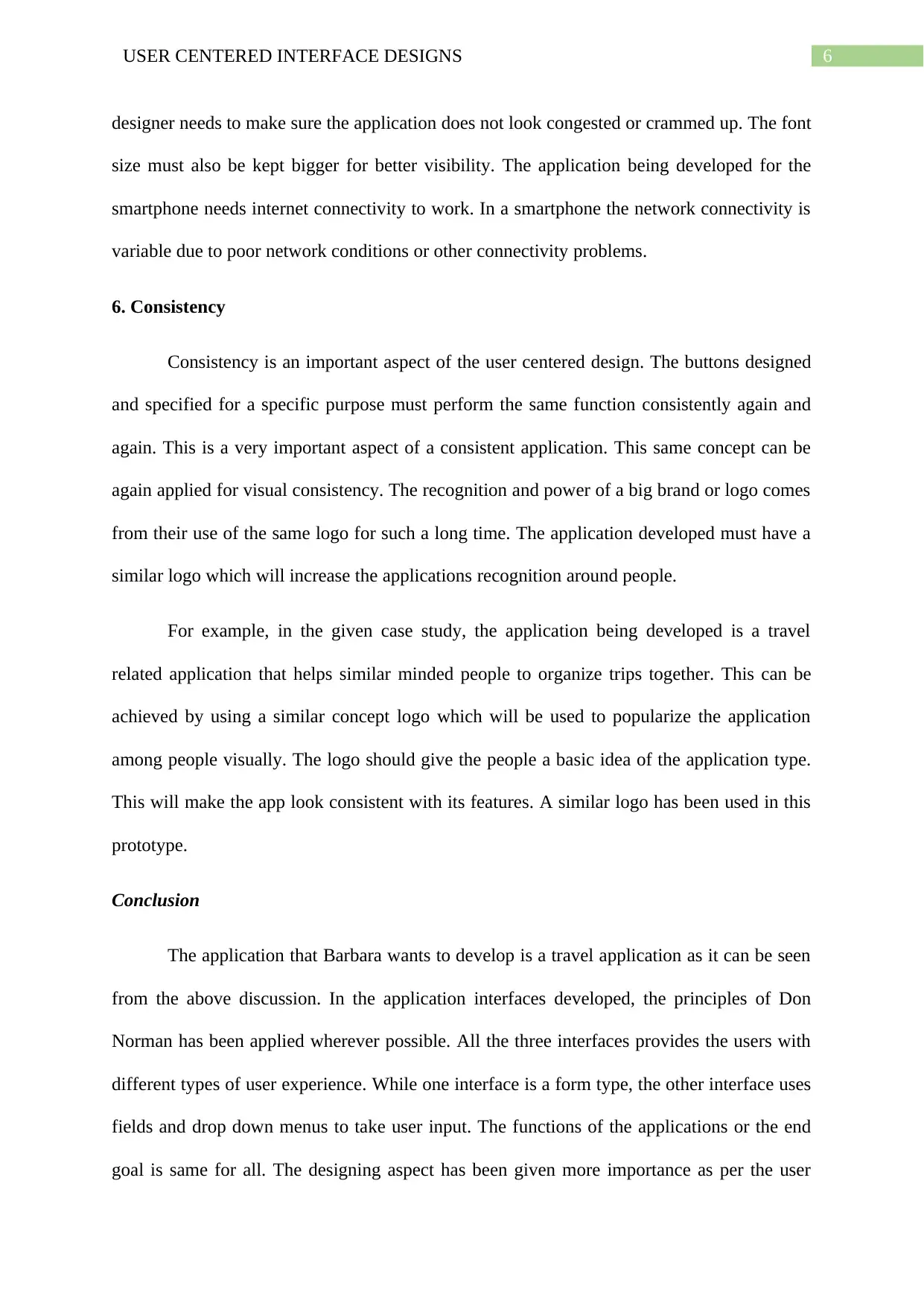
6USER CENTERED INTERFACE DESIGNS
designer needs to make sure the application does not look congested or crammed up. The font
size must also be kept bigger for better visibility. The application being developed for the
smartphone needs internet connectivity to work. In a smartphone the network connectivity is
variable due to poor network conditions or other connectivity problems.
6. Consistency
Consistency is an important aspect of the user centered design. The buttons designed
and specified for a specific purpose must perform the same function consistently again and
again. This is a very important aspect of a consistent application. This same concept can be
again applied for visual consistency. The recognition and power of a big brand or logo comes
from their use of the same logo for such a long time. The application developed must have a
similar logo which will increase the applications recognition around people.
For example, in the given case study, the application being developed is a travel
related application that helps similar minded people to organize trips together. This can be
achieved by using a similar concept logo which will be used to popularize the application
among people visually. The logo should give the people a basic idea of the application type.
This will make the app look consistent with its features. A similar logo has been used in this
prototype.
Conclusion
The application that Barbara wants to develop is a travel application as it can be seen
from the above discussion. In the application interfaces developed, the principles of Don
Norman has been applied wherever possible. All the three interfaces provides the users with
different types of user experience. While one interface is a form type, the other interface uses
fields and drop down menus to take user input. The functions of the applications or the end
goal is same for all. The designing aspect has been given more importance as per the user
designer needs to make sure the application does not look congested or crammed up. The font
size must also be kept bigger for better visibility. The application being developed for the
smartphone needs internet connectivity to work. In a smartphone the network connectivity is
variable due to poor network conditions or other connectivity problems.
6. Consistency
Consistency is an important aspect of the user centered design. The buttons designed
and specified for a specific purpose must perform the same function consistently again and
again. This is a very important aspect of a consistent application. This same concept can be
again applied for visual consistency. The recognition and power of a big brand or logo comes
from their use of the same logo for such a long time. The application developed must have a
similar logo which will increase the applications recognition around people.
For example, in the given case study, the application being developed is a travel
related application that helps similar minded people to organize trips together. This can be
achieved by using a similar concept logo which will be used to popularize the application
among people visually. The logo should give the people a basic idea of the application type.
This will make the app look consistent with its features. A similar logo has been used in this
prototype.
Conclusion
The application that Barbara wants to develop is a travel application as it can be seen
from the above discussion. In the application interfaces developed, the principles of Don
Norman has been applied wherever possible. All the three interfaces provides the users with
different types of user experience. While one interface is a form type, the other interface uses
fields and drop down menus to take user input. The functions of the applications or the end
goal is same for all. The designing aspect has been given more importance as per the user
Paraphrase This Document
Need a fresh take? Get an instant paraphrase of this document with our AI Paraphraser
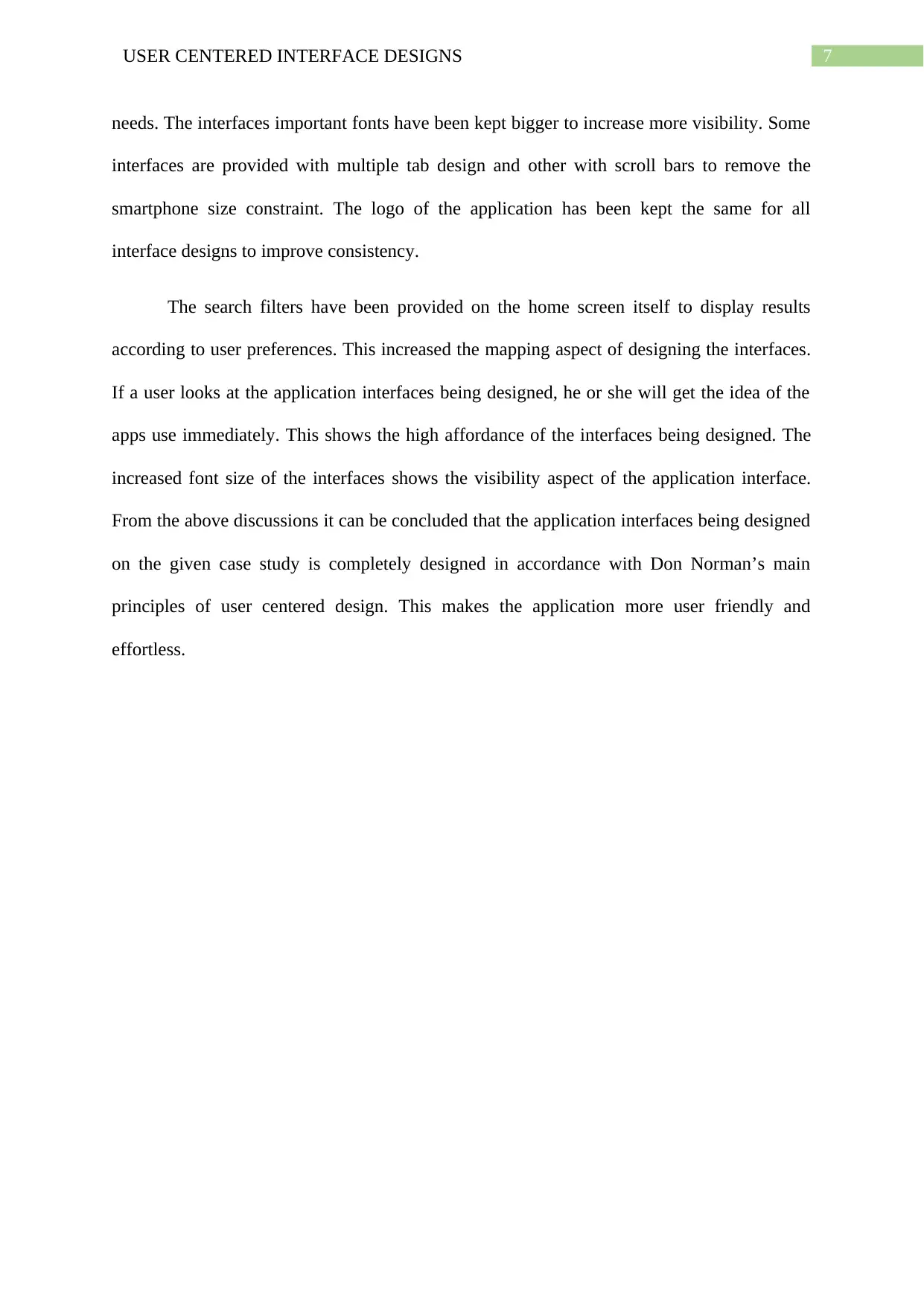
7USER CENTERED INTERFACE DESIGNS
needs. The interfaces important fonts have been kept bigger to increase more visibility. Some
interfaces are provided with multiple tab design and other with scroll bars to remove the
smartphone size constraint. The logo of the application has been kept the same for all
interface designs to improve consistency.
The search filters have been provided on the home screen itself to display results
according to user preferences. This increased the mapping aspect of designing the interfaces.
If a user looks at the application interfaces being designed, he or she will get the idea of the
apps use immediately. This shows the high affordance of the interfaces being designed. The
increased font size of the interfaces shows the visibility aspect of the application interface.
From the above discussions it can be concluded that the application interfaces being designed
on the given case study is completely designed in accordance with Don Norman’s main
principles of user centered design. This makes the application more user friendly and
effortless.
needs. The interfaces important fonts have been kept bigger to increase more visibility. Some
interfaces are provided with multiple tab design and other with scroll bars to remove the
smartphone size constraint. The logo of the application has been kept the same for all
interface designs to improve consistency.
The search filters have been provided on the home screen itself to display results
according to user preferences. This increased the mapping aspect of designing the interfaces.
If a user looks at the application interfaces being designed, he or she will get the idea of the
apps use immediately. This shows the high affordance of the interfaces being designed. The
increased font size of the interfaces shows the visibility aspect of the application interface.
From the above discussions it can be concluded that the application interfaces being designed
on the given case study is completely designed in accordance with Don Norman’s main
principles of user centered design. This makes the application more user friendly and
effortless.

8USER CENTERED INTERFACE DESIGNS
References
Abras, C., Maloney-Krichmar, D. and Preece, J., 2004. User-centered design. Bainbridge, W.
Encyclopedia of Human-Computer Interaction. Thousand Oaks: Sage Publications, 37(4),
pp.445-456.
Ahamed, M.M. and Bakar, Z.B.A., 2017. Triangle Model Theory for Enhance the Usability
by User Centered Design Process in Human Computer Interaction. International Journal on
Contemporary Computer Research (IJCCR), 1(2), pp.26-32.
Bohemia, E., Neubauer, R. and Harman, K., 2019. Rethinking design: From the methodology
of innovation to the object of design.
Cosgrove, S., 2018. Review of Fundamentals of User-Centered Design: A Practical
Approach, by Still, B., & Crane, K.(2017). Boca Raton, FL: CRC Press. Communication
Design Quarterly Review, 5(3), pp.74-77.
Dam, R. and Siang, T., 2018. What is design thinking and why is it so popular. Retrieved
July, 10.
Dorrington, P., Wilkinson, C., Tasker, L. and Walters, A., 2016. User-centered design
method for the design of assistive switch devices to improve user experience, accessibility,
and independence. Journal of Usability Studies, 11(2), pp.66-82.
Lanter, D. and Essinger, R., 2016. User‐Centered Design. International Encyclopedia of
Geography: People, the Earth, Environment and Technology: People, the Earth,
Environment and Technology, pp.1-4.
Lin, C.J. and Cheng, L.Y., 2017. Product attributes and user experience design: how to
convey product information through user-centered service. Journal of Intelligent
Manufacturing, 28(7), pp.1743-1754.
References
Abras, C., Maloney-Krichmar, D. and Preece, J., 2004. User-centered design. Bainbridge, W.
Encyclopedia of Human-Computer Interaction. Thousand Oaks: Sage Publications, 37(4),
pp.445-456.
Ahamed, M.M. and Bakar, Z.B.A., 2017. Triangle Model Theory for Enhance the Usability
by User Centered Design Process in Human Computer Interaction. International Journal on
Contemporary Computer Research (IJCCR), 1(2), pp.26-32.
Bohemia, E., Neubauer, R. and Harman, K., 2019. Rethinking design: From the methodology
of innovation to the object of design.
Cosgrove, S., 2018. Review of Fundamentals of User-Centered Design: A Practical
Approach, by Still, B., & Crane, K.(2017). Boca Raton, FL: CRC Press. Communication
Design Quarterly Review, 5(3), pp.74-77.
Dam, R. and Siang, T., 2018. What is design thinking and why is it so popular. Retrieved
July, 10.
Dorrington, P., Wilkinson, C., Tasker, L. and Walters, A., 2016. User-centered design
method for the design of assistive switch devices to improve user experience, accessibility,
and independence. Journal of Usability Studies, 11(2), pp.66-82.
Lanter, D. and Essinger, R., 2016. User‐Centered Design. International Encyclopedia of
Geography: People, the Earth, Environment and Technology: People, the Earth,
Environment and Technology, pp.1-4.
Lin, C.J. and Cheng, L.Y., 2017. Product attributes and user experience design: how to
convey product information through user-centered service. Journal of Intelligent
Manufacturing, 28(7), pp.1743-1754.
⊘ This is a preview!⊘
Do you want full access?
Subscribe today to unlock all pages.

Trusted by 1+ million students worldwide
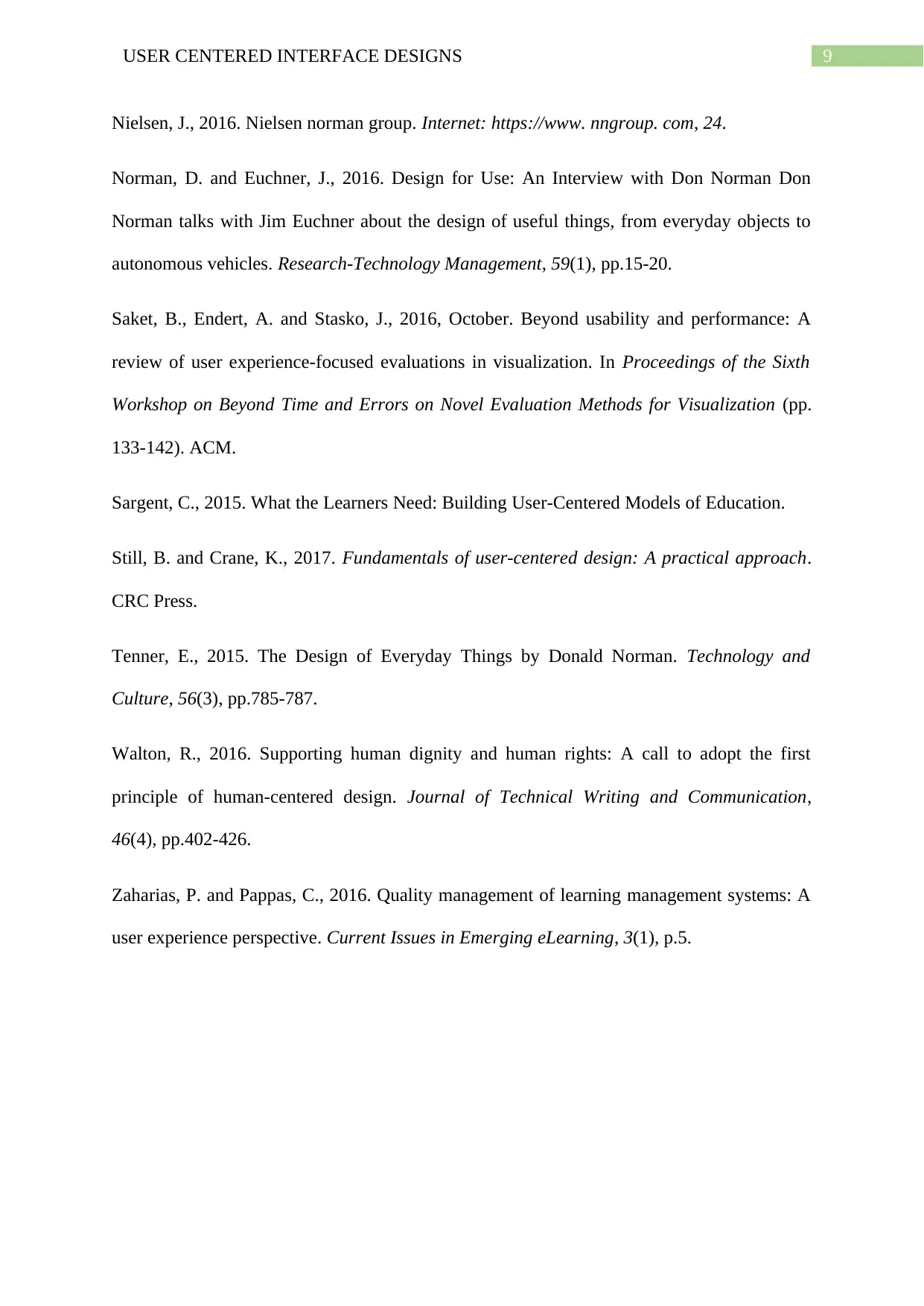
9USER CENTERED INTERFACE DESIGNS
Nielsen, J., 2016. Nielsen norman group. Internet: https://www. nngroup. com, 24.
Norman, D. and Euchner, J., 2016. Design for Use: An Interview with Don Norman Don
Norman talks with Jim Euchner about the design of useful things, from everyday objects to
autonomous vehicles. Research-Technology Management, 59(1), pp.15-20.
Saket, B., Endert, A. and Stasko, J., 2016, October. Beyond usability and performance: A
review of user experience-focused evaluations in visualization. In Proceedings of the Sixth
Workshop on Beyond Time and Errors on Novel Evaluation Methods for Visualization (pp.
133-142). ACM.
Sargent, C., 2015. What the Learners Need: Building User-Centered Models of Education.
Still, B. and Crane, K., 2017. Fundamentals of user-centered design: A practical approach.
CRC Press.
Tenner, E., 2015. The Design of Everyday Things by Donald Norman. Technology and
Culture, 56(3), pp.785-787.
Walton, R., 2016. Supporting human dignity and human rights: A call to adopt the first
principle of human-centered design. Journal of Technical Writing and Communication,
46(4), pp.402-426.
Zaharias, P. and Pappas, C., 2016. Quality management of learning management systems: A
user experience perspective. Current Issues in Emerging eLearning, 3(1), p.5.
Nielsen, J., 2016. Nielsen norman group. Internet: https://www. nngroup. com, 24.
Norman, D. and Euchner, J., 2016. Design for Use: An Interview with Don Norman Don
Norman talks with Jim Euchner about the design of useful things, from everyday objects to
autonomous vehicles. Research-Technology Management, 59(1), pp.15-20.
Saket, B., Endert, A. and Stasko, J., 2016, October. Beyond usability and performance: A
review of user experience-focused evaluations in visualization. In Proceedings of the Sixth
Workshop on Beyond Time and Errors on Novel Evaluation Methods for Visualization (pp.
133-142). ACM.
Sargent, C., 2015. What the Learners Need: Building User-Centered Models of Education.
Still, B. and Crane, K., 2017. Fundamentals of user-centered design: A practical approach.
CRC Press.
Tenner, E., 2015. The Design of Everyday Things by Donald Norman. Technology and
Culture, 56(3), pp.785-787.
Walton, R., 2016. Supporting human dignity and human rights: A call to adopt the first
principle of human-centered design. Journal of Technical Writing and Communication,
46(4), pp.402-426.
Zaharias, P. and Pappas, C., 2016. Quality management of learning management systems: A
user experience perspective. Current Issues in Emerging eLearning, 3(1), p.5.
Paraphrase This Document
Need a fresh take? Get an instant paraphrase of this document with our AI Paraphraser

10USER CENTERED INTERFACE DESIGNS
1 out of 11
Your All-in-One AI-Powered Toolkit for Academic Success.
+13062052269
info@desklib.com
Available 24*7 on WhatsApp / Email
![[object Object]](/_next/static/media/star-bottom.7253800d.svg)
Unlock your academic potential
Copyright © 2020–2025 A2Z Services. All Rights Reserved. Developed and managed by ZUCOL.

